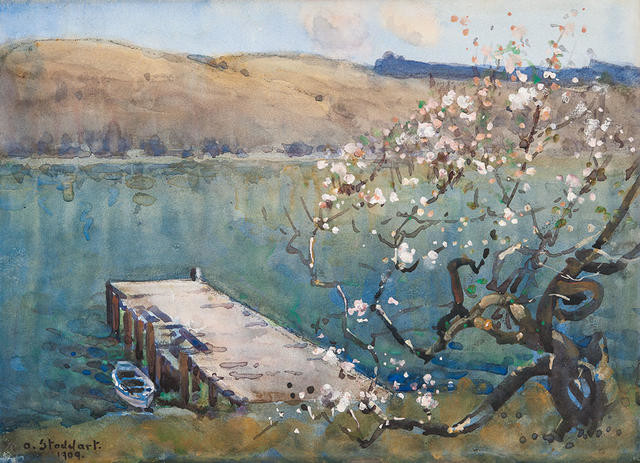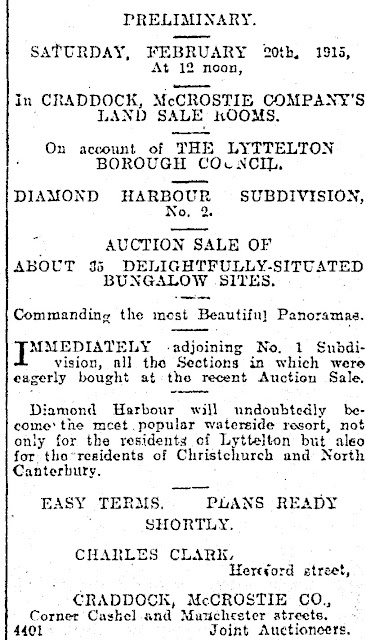Diamond Harbour #4: A bigger, safer jetty
My last post on Diamond Harbour ended in 1911 with the Lyttelton Harbour Board closing the jetty which it considered unsafe for use. Mark Stoddart's widow, Anna, had expressed concern about the encroachment of the sea on the approach to the jetty but the Harbour Board would not pay for the necessary work until a 'fairly graded road' enabled access through the Stoddart property. Stalemate.
 |
| Margaret Stoddart's painting of the 'old' jetty, 1909 (note no handrails). Margaret Stoddart, Diamond Harbour, Collection of Christchurch Art Gallery Te Puna o Waiwhetū; Christchurch Art Gallery Trust Collection. https:// |
Anna Stoddart died in June 1911, three years after the death of her daughter Mary in childbirth. The remaining members of the Stoddart family decided to move on from the large Diamond Harbour estate. At much the same time the Lyttelton Borough Council was thinking of extending its boundaries to include a ‘marine suburb’ or ‘trans-harbour township’ which would offer Lyttelton workers the option of a warmer, healthier place in which to live while commuting by ferry to the port for work. By October 1911, the Lyttelton Borough Extension Act had been passed, enabling the council to purchase land outside the limits of the borough. Specifically the council was eyeing up the 350 acre Diamond Harbour estate for subdivision. This had immediate implications for the Diamond Harbour jetty, little changed since first built for Mark Stoddart around 1857.
It shall be lawful for the Corporation to establish, or assist in establishing, or to subsidize out of its ordinary revenue, for such period as it may consider fit, a ferry service between the present Lyttelton Borough and the south side of Lyttelton Harbour, and to contribute by lump sum or annual payment towards the construction or upkeep of any wharf or jetty which may be required for the convenience of persons residing or proposing to reside on the south side of Lyttelton Harbour.{1}
On the 16 March 1912 the Mayor of Lyttelton hosted a picnic on the Stoddart estate, offering an opportunity for Lyttelton residents to view the proposed new subdivision. The mayor, M.J. Millar, engaged the steamers Purau, Canterbury and Monica to take visitors across the harbour. (Presumably the jetty closure was conveniently waived?).
The Mayor of Lyttelton was giving a free treat to all that liked to go from Lyttelton to the Stoddarts just for the public to see how nice it was... The Stoddart gardens are lovely and should not have been entered but hundreds of the public rushed the grounds and stole all they could carry. I never saw anything like it, a disgrace to civilisation.[2]
Since there was dissension in the ranks of the Lyttelton Borough Council over the cost of the proposed development it was decided hold a ratepayers’ poll on the proposal to raise a loan of £15,000 for the purchase and development of the Diamond Harbour estate (£7000 for the estate and the rest for roading, sea transport and other services). The poll was held on the 5 February 1913. The polling was described as ‘fairly heavy’ with 478 votes being cast out of a roll of about 700. In a somewhat split vote, two hundred and fifty voted for the proposal and 216 against.[3]
The subdivision was then rolled out in stages. Seventy-six quarter-acre sections (eight of which were reserved for a water reservoir) were put up for auction in November 1914 with a further 35 being offered in February 1915.
 |
| Lyttelton Times, 28 November 1914 |
 |
| Press, 3 January 1915 |
The jetty was reopened in November 1913. The launch Canterbury was chartered for six months and then the Ruahine was purchased for £360 for the Diamond Harbour service. Godley House was renovated and opened for accommodation. However both the ferry and, very soon, Godley House, ran at a loss. Private launch owners were unhappy with the unfair competition from the municipal authority. The council decided to put the operation of both ferry service and accommodation out to private tender. A. Rhind and Company won the ferry tender.
By 1913 the Lyttelton mayor was talking about the possibility of two jetties, maybe three. However the condition of the only existing jetty - which had been deemed unsafe and closed in 1911 - was a cause for concern.
A smart rescue was affected at Diamond Harbour yesterday afternoon by a lad named Roland Stewart. A woman was walking down the steps at the jetty to the ferry launch Ruahine, leading a little child by the hand. The youngster slipped from the woman’s grip into the water, and the boy, without a moment’s hesitation, plunged in fully dressed, and got the little one safely on board the launch.[4]
A purpose-built wharf was needed at Diamond Harbour to service (as it was thought) the increased passenger and freight traffic. By 1913 the Lyttelton mayor was talking optimistically about the possibility of two jetties, maybe three. In the meantime, the “rebuilding of the old jetty with enlargements and improvements”[5] began 21 June 1915 and was completed by August.
Five months later,
people [were] appearing on the landing jetty in costumes other than the regulation neck-to-knee suit. In order to check such practices, it was decided to take certain steps, and also to display notices to the effect that bathing would not be allowed about the jetty between the hours of 8.00am and 7.00pm.[6]
 |
| Margaret Stoddart's painting of the 'old' jetty, 1909. Margaret Stoddart, Diamond Harbour, Collection of Christchurch Art Gallery Te Puna o Waiwhetū; Christchurch Art Gallery Trust Collection. https:// |
 |
| Jayden Robert's painting of the old jetty, after Margaret Stoddart. Stoddart Cottage exhibition 'Impressionable', Diamond Harbour August 2018 (my photo, hence the angle) |
 |
| Planned alterations to Diamond Harbour jetty, 31 December 1914, Lyttelton Harbour Board, Archives NZ/ECan MA50C/1/450 |
 |
| Margaret Stoddart's painting of the 'new' jetty. Margaret Stoddart, The Old Almond Tree, WS and Alison MacGibbon Collection, University of Canterbury |
[1] Lyttelton Borough Extension Act, 1911, No. 36, 7b http://www.nzlii.org/nz/legis/hist_act/lbea19112gv1911n36460/
[2] March 16 1912, Diary of E. R. Chudleigh 1866-1921, quoted in King (1997) Flowers into Landscape: Margaret Stoddart 1865-1934, p. 85
[3] Star, 6 February 1913
[4] Press, 23 January 1915
[5] Star, 6 August 1915
[6] Press 18 January 1916


Comments
Post a Comment